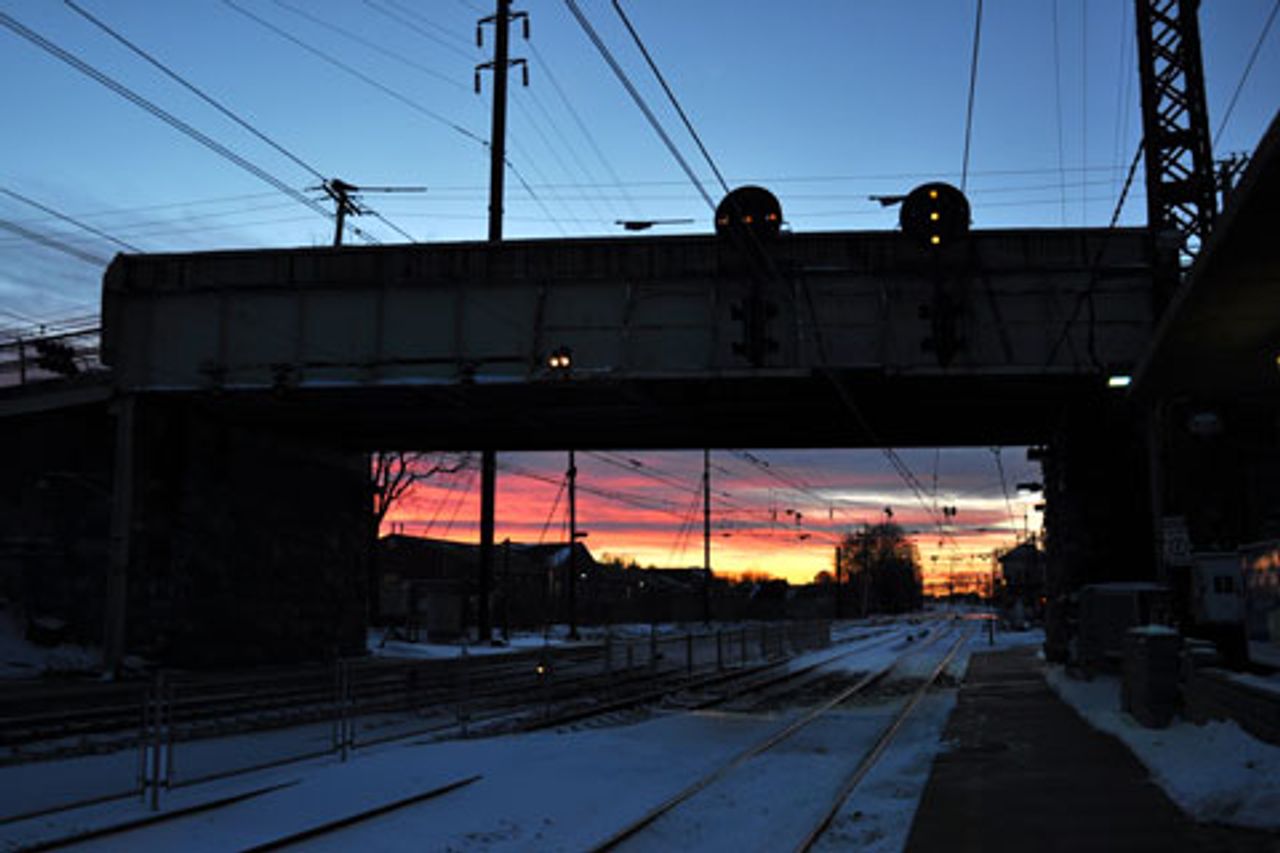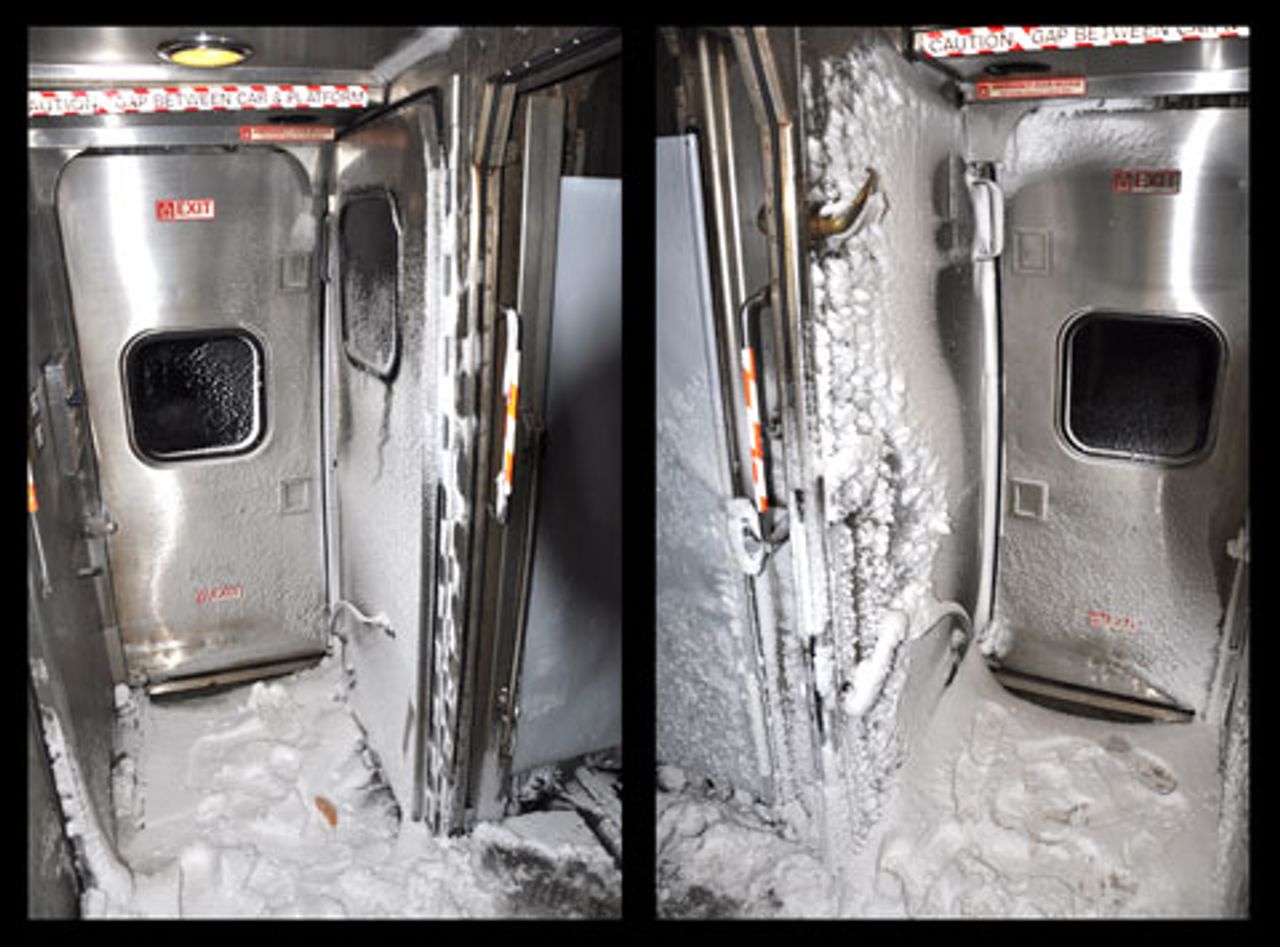The blizzard of 2010 occurred throughout Sunday, December 26, and into Monday, the 27th. On this day I was set to depart on an Amtrak train from Paoli, Pennsylvania, headed westbound. Areas along the Atlantic coast, most notably New York City, had seen the worst of the snowfall. Airports were shut down, bus service was halted, and in the city itself, nearly all public and private transit fell into disarray.
 The sun sets as I wait on a train that would normally arrive at midday. There was no announcement of its arrival, so several passengers had to scramble over the snow- and ice-covered bridge, and barely made it onto the train.
The sun sets as I wait on a train that would normally arrive at midday. There was no announcement of its arrival, so several passengers had to scramble over the snow- and ice-covered bridge, and barely made it onto the train.Paoli and Philadelphia did not receive as much snow as New York City, but unfortunately, my train originated there. Storm related difficulties caused it to leave three hours late, and further weather issues had it finally arrive 3 hours, 50 minutes late.
Amtrak was practically the only transportation still operating in the region during the worst of the storm. It was clear that employees were working hard to overcome tremendous weather-related difficulties, and the same could likely be said about airline and bus company staff. Nevertheless, a dismal, cynical mood dominated on the platform. Notably, it seemed to stem more from poor communication and infrastructure rather than simply lateness.
For example, the reporting from Amtrak on the status of the train was very minimal; status updates on the train’s estimated arrival time would linger for 30 and 45 minutes after the time had passed. This really seemed to play havoc on passengers at this station in particular, as the station and warm waiting room are the south (eastbound) side of the tracks, and crossing requires lugging everything up stairs and over a steep bridge, covered with snow and ice.
On the north side of the tracks, where we were to board, there was simply a bench and unheated shelter—while weather at the time was high winds and below-freezing temperatures. There was no announcement board outside of the train’s status, and the heated station room was only staffed by a commuter agency employee who did not have information on Amtrak.
Passengers therefore either had to call or check the status online, which only gave them infrequent updates. Some chose to suffer in the cold, while the delay was continually extended. Others in the waiting room only saw the train upon arrival, and had to run up and across the steep, snow and ice covered bridge barely in time to board the train.
Once onboard the train operated smoothly. Within minutes, though, the conductor announced that the train would be not be operating past Harrisburg—just 40 minutes away—as there was a derailment ahead blocking all tracks. A Norfolk Southern freight train crossing the long Rockville Bridge over the Susquehanna River had a few shipping containers blown off and cars tipped over by the strong lingering storm winds.
Incredibly, the last time I took this train west through Pennsylvania, in 2007, it also was cancelled in Harrisburg. That time, a Norfolk Southern freight train of ethanol derailed and burst into flames outside of Pittsburgh.
 The entrance to the rail car gives a sense of the severity of the weather. A mist of fluffy snow was coming through a leaky seal as I took the picture.
The entrance to the rail car gives a sense of the severity of the weather. A mist of fluffy snow was coming through a leaky seal as I took the picture.Hearing the announcement of the cancellation, the laughter and groans erupted. Some of the passengers, if not many, were airline refugees, and spoke of people fighting to get on airport shuttle buses, and Delta Airlines trying to reschedule them for three days after their canceled flights. A four-hour late train that is canceled nearly as soon as one sits down seemed like adding insult to injury.
For such exceptional circumstances, Amtrak did a quite excellent job arranging alternate transportation. Within 10-40 minutes of arriving in Harrisburg, all passengers had boarded buses continuing on to their destinations. Some passengers from canceled flights were surprised, after airlines had told them to “wait it out” (for days) to get new flights.
Ironically, boarding a bus to go non-stop on the Pennsylvania Turnpike to Pittsburgh wound up getting us there about 90 minutes faster than the train would have. The train would have used a route built before the Civil War, filled with steep grades, innumerable curves, and busy freight traffic, all of which often serve to keep the speed below 50 mph.
Overall, the railroad employees and bus drivers did an outstanding job to ensure passengers were kept moving during fierce travel conditions.
Yet this effort was nevertheless constrained by outdated and under-funded infrastructure. From Sunday into Monday, during the entirety of the storm, Amtrak was able to keep trains operating between New York and Philadelphia, its busiest segment in the country. Yet late Monday afternoon, as the snowfall ended, service was suspended due to signal problems—no doubt related to ancient signaling and electrical infrastructure, some of which dates to the Depression.
The cars for many of Amtrak’s long-distance trains are serviced in a yard in Brooklyn, New York. Though it is a maintenance base, the yard is open air, making work difficult during inclement weather. To add to this, workers had difficulties getting to work throughout and after the blizzard. And as the WSWS has noted (See “New York City services come to a halt after blizzard”) it has taken days for the city to plow some streets in Brooklyn. So these trains left hours late on Monday night; one was 11 hours and 50 minutes late departing New York City.
One wonders—how much coordination was developed between the airlines, bus companies, and Amtrak to accommodate the tens of thousands of stranded airline passengers in the New York region?
I traveled with airline refugees on Monday/Tuesday, and know someone else who did even on Wednesday/Thursday. Yet Amtrak—perpetually asked to beg yearly for miserly subsidies from Congress—has very little room to accommodate a surge in travelers. Most long-distance trains only run once a day, and can scarcely even have cars added as there are few extra cars available.
Some of Amtrak’s equipment is so old it could be ridden as historical experience—one can ride a dining car built in the early 1950s, or have their luggage placed in a baggage car from the late 1940s. Nearly all other passenger cars range between 20 and 40 years old. Roughly $300 million was recently announced for the purchase of 130 new cars, but these will all be baggage, diner and sleeping cars, meant to replace the above mentioned museum relics. Aging coaches, which carry the vast majority of paying passengers, as of yet have no replacement, much less any expansion.
